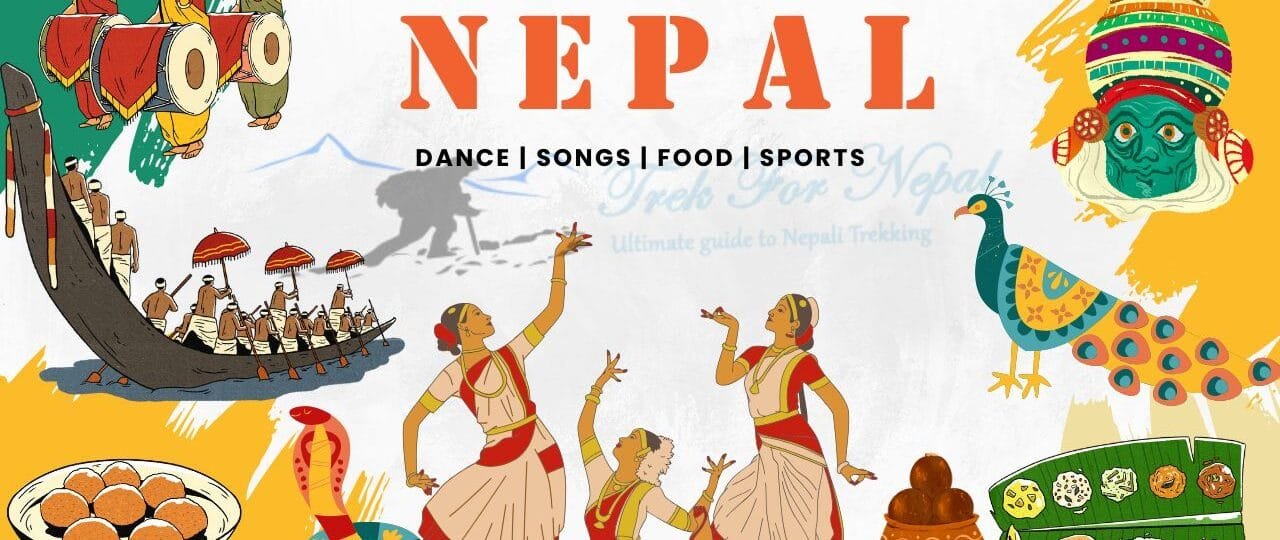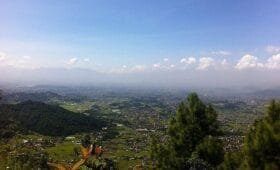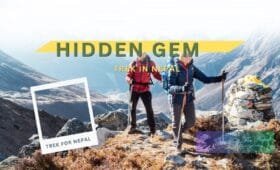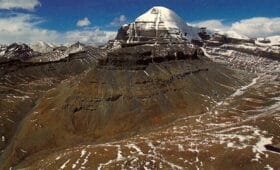Introduction
Imagine trekking through some of the world’s most breathtaking landscapes, only to stumble upon ancient monasteries, vibrant festivals, and traditional villages that tell stories of cultures older than the mountains themselves. That’s Nepal for you—a treasure trove of natural beauty paired with an unmatched cultural experience.
Cultural Trekking in Nepal is more than just an adventure; it’s a deep dive into the heart of Himalayan culture. From the peaceful chants of monks in remote monasteries to the lively festivities of Nepal’s many cultural celebrations, there’s a world of experiences waiting for you. In this guide, we’ll explore the highlights of Cultural Trekking in Nepal, covering monasteries, festivals, villages, and much more.
1. Explore Ancient Monasteries and Spiritual Sites
Trekking in Nepal often feels like a spiritual journey, thanks to the many monasteries scattered along the trails. These sacred spaces, some perched on hilltops and others hidden in lush valleys, are not just places of worship but living museums of Nepal’s rich spiritual heritage.
Monasteries You Can’t-Miss
- Tengboche Monastery (Everest Region): Nestled against the backdrop of Mount Everest, this iconic monastery is a spiritual hub for trekkers. You’ll witness colourful prayer flags, spinning prayer wheels, and the rhythmic chants of monks.
- Kopan Monastery (Kathmandu): A serene retreat for meditation and learning, perfect for anyone seeking a deeper connection with Buddhism.
- Lama Hotel (Langtang Valley): While the name might mislead, it’s a quaint stop with a small monastery nearby, offering a peaceful atmosphere amidst the rugged terrain.
Why It’s a Cultural Highlight: Visiting monasteries lets you experience Nepal’s spiritual essence, from the flutter of prayer flags to the meditative hum of ancient rituals. These moments provide a calm, grounding counterbalance to the physical challenge of trekking.
2. Celebrate Vibrant Local Festivals
Nepal’s festivals are as colourful as its landscapes, blending spirituality, tradition, and joy. Trekking during festival seasons offers a unique opportunity to immerse yourself in local culture. Imagine trails decorated with lamps, lively dances in villages, and feasts shared with welcoming locals.
Festivals to Experience While Trekking
- Tihar (Festival of Lights): Often compared to Diwali, this festival is celebrated with oil lamps, colourful decorations, and rituals honouring animals like crows, cows, and dogs. It’s a magical time to trek through the Annapurna or Langtang regions.
- Lhosar (Tibetan New Year): A major celebration for Sherpa and Tibetan communities, Lhosar is marked by traditional dances, music, and feasts. Namche Bazaar in the Everest region is an excellent place to experience it.
- Buddha Jayanti: Celebrated with grandeur at Lumbini, the birthplace of Buddha, this festival includes processions, prayers, and offerings that pay homage to Buddha’s life.
Why It’s a Cultural Highlight: Festivals in Nepal are a window into the country’s soul, showcasing its deep-rooted connection to spirituality, nature, and community.
3. Discover Traditional Villages Along the Trails
One of the most rewarding aspects of Cultural Trekking in Nepal is the chance to connect with local communities in traditional villages. These villages are not just picturesque stops but vibrant centres of culture and hospitality.
Villages Worth Visiting
- Ghandruk (Annapurna Region): This Gurung village offers stunning mountain views, traditional architecture, and insights into local culture. Don’t miss trying homemade Gurung dishes here.
- Sherpa Villages (Everest Region): Villages like Namche Bazaar and Khumjung are rich in Sherpa culture, blending Tibetan Buddhist traditions with warm hospitality.
- Lho Village (Manaslu Region): A quaint settlement that provides an authentic look at the mountain lifestyle, complete with stone houses and terraced fields.
Why It’s a Cultural Highlight: Interacting with locals in these villages lets you experience their way of life—simple, sustainable, and deeply connected to nature.
4. Experience Nepal’s Incredible Cultural Diversity
Nepal is home to over 120 ethnic groups, each with its language, traditions, and lifestyle. Trekking through its diverse regions gives you a unique opportunity to see how these communities coexist while maintaining their distinct identities.
Cultural Communities to Explore
- Sherpas (Everest Region): Famous for their mountaineering skills, Sherpas follow Tibetan Buddhist traditions and are known for their resilience and kindness.
- Gurungs (Annapurna Region): This community is celebrated for its hospitality and unique dances, such as the traditional Gurung Ghatu.
- Tamang (Langtang Region): The Tamang people offer a glimpse into a lifestyle harmonized with the mountains, featuring colourful festivals, handcrafted items, and delicious cuisine.
Why It’s a Cultural Highlight: Every step of your trek introduces you to new traditions, cuisines, and customs, making your journey as culturally enriching as it is physically rewarding.
5. Immerse Yourself in Rural Life
Beyond the festivals and monasteries, Cultural Trekking in Nepal gives you a firsthand look at rural life. From terraced fields to bustling local markets, you’ll see how Nepali communities live in harmony with the land.
Ways to Experience Rural Life
- Stay with Local Families: Opt for homestays in villages where you can enjoy home-cooked meals and learn about traditional farming and cooking methods.
- Visit Local Markets: Markets in places like Namche Bazaar and Ghandruk are perfect for buying handicrafts, spices, and local goods while mingling with locals.
- Observe Farming Practices: Watch or even participate in traditional farming techniques, such as ploughing fields with oxen or harvesting by hand.
Why It’s a Cultural Highlight: Life in rural Nepal moves at a slower pace, offering a refreshing break from the hustle of modern life and a deeper appreciation for sustainable living.
6. Cultural Etiquette and Tips
When Cultural Trekking in Nepal, respecting local culture is essential. Here are a few tips to ensure your interactions are meaningful and respectful:
- Always ask for permission before photographing people or religious sites.
- Dress modestly, especially in villages and monasteries.
- Learn a few Nepali phrases, such as “Namaste” (hello) and “Dhanyabad” (thank you). Locals appreciate the effort.
- Be mindful of religious customs, such as walking clockwise around stupas or not touching sacred objects.
Conclusion
Cultural Trekking in Nepal is about more than just reaching the summit or ticking off a bucket-list adventure. It’s about the people you meet, the traditions you witness, and the stories you carry back home. From the serene monasteries to the lively festivals and welcoming villages, Nepal offers a cultural richness that will stay with you long after your trek ends.
So, whether you’re seeking spiritual insights, cultural immersion, or just a deeper connection with the world around you, trekking in Nepal promises an unforgettable journey. Pack your bags, lace up your boots, and get ready to experience the perfect blend of adventure and culture!
FAQ Section
1. What cultural experiences can I have while trekking in Nepal?
You can visit ancient monasteries, participate in local festivals, interact with traditional villages, and learn about Nepal’s diverse cultural practices while trekking.
2. How do I interact with local communities while trekking?
You can engage with locals by staying in village lodges, visiting local markets, and participating in cultural activities such as festivals or cooking meals with families.
3. Which festivals can I experience while trekking in Nepal?
You can experience festivals like Tihar, Lhosar, and Buddha Jayanti depending on the region and time of year.
4. What are the most culturally rich trekking regions in Nepal?
Regions like Everest, Annapurna, and Langtang are known for their rich cultural heritage and provide trekkers with the opportunity to engage with local communities and experience authentic cultural practices.
5. Can I visit monasteries during my trek?
Yes, many trekking routes in Nepal, such as Tengboche Monastery in the Everest region, allow trekkers to visit monasteries and experience local Buddhist practices.
By trekking in Nepal, you not only get to witness some of the world’s most beautiful landscapes but also experience the vibrant and diverse cultures that make this country so unique. Happy trekking and cultural exploration!




